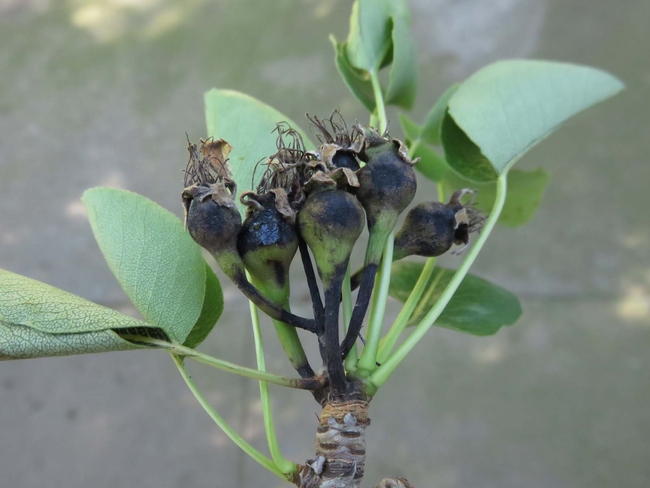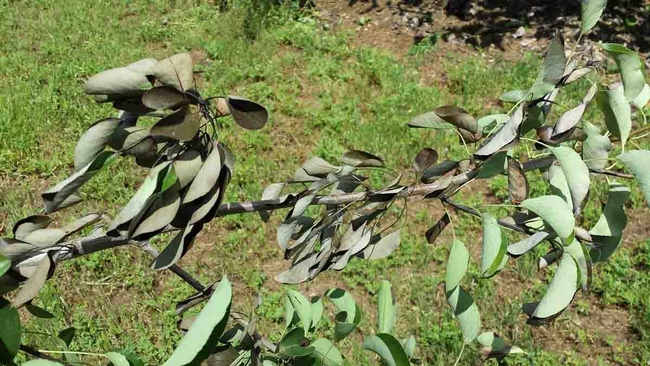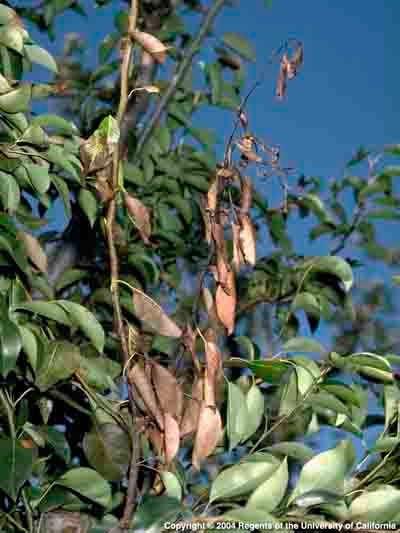If you are noticing droopy, dried-out flower clusters on your pears, Asian pears, quince, apples or crabapples, fire blight may be the cause.

The first sign of fire blight is often the blackening of flowers, shoots or leaves followed by a watery, light tan ooze from affected shoots. Open flowers are the most common infection site and remain susceptible until petal fall.
Initially, fire blight infections might be localized, affecting only a flower cluster, but then the infection grows downward, extending into twigs and branches. These twig cankers kill more and more tissue as they advance. Dead, blackened leaves and fruit cling to dead branches throughout the season, giving the tree a scorched appearance -- hence the name “fire blight.” The pathogen can kill highly susceptible trees, while others may suffer significant branch dieback. Once infected, the plant will harbor the pathogen indefinitely unless the cankers are pruned out well below the infection.

Monitoring trees regularly, a couple of times a week, will allow you to identify and deal with new fire blight strikes before they become a branch infection. It is important to remove and destroy any new fire blight infections before they spread and affect more tissue. Dip pruning shears in a 10-percent bleach solution after each cut.
If fire blight strikes have been ignored, the infection will spread and infect the branch. Once the wood is infected, the branch must be pruned out well below the infection. In this case, you will need to remove the diseased wood in summer or winter when the bacteria are no longer spreading through the tree. Again, dip pruning shears in a 10-percent bleach solution after each cut.

If fire blight occurs on a trunk or major limb the wood may be saved by scraping away the bark down to the cambium layer in affected areas (removing both outer and inner bark). When scraping look for long, narrow infections that can extend farther down the branch or trunk. If any are seen, remove all discolored tissue plus six to eight inches more beyond the infection. This procedure is best done in winter when trees are dormant and bacteria aren't active. Don't apply any dressing to the wound. If the limb has been girdled, scraping won't work and the entire limb must be removed.
When selecting new fruit trees, choose those that are less susceptible to fire blight, if possible. The most susceptible varieties are Fuji, Gala, Golden Delicious, Granny Smith, Gravenstein, Jonathan, Mutsu, Pink Lady and Yellow Newton. Unfortunately, most pear varieties are susceptible to fire blight.

PLANT SALE! Mark your calendar for our plant sale onSaturday, May 18, 2024 from 9 am–noon. The sale will be held at the Master Gardeners Demonstration Garden at Patrick Ranch. The plants, which are selected to thrive in our climate, have been propagated by UC Master Gardeners of Butte County. For more information and a partial list of the plants that will available, visit our website.
UC Master Gardeners of Butte County are part of the University of California Cooperative Extension (UCCE) system. To learn more about us and our upcoming events, and for help with gardening in our area visit our website. If you have a gardening question or problem, email the Hotline at mgbutte@ucanr.edu or leave a phone message on our Hotline at 530-552-5812. To speak to a Master Gardener about a gardening issue, or to drop by the MG office during Hotline hours, see the most current information on our Ask Us section of our website.


